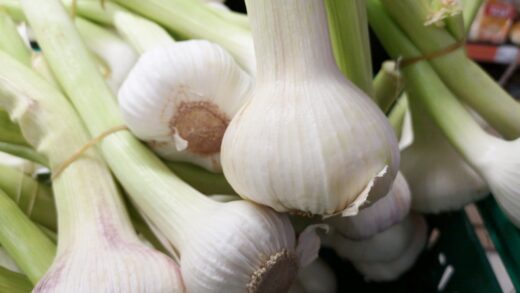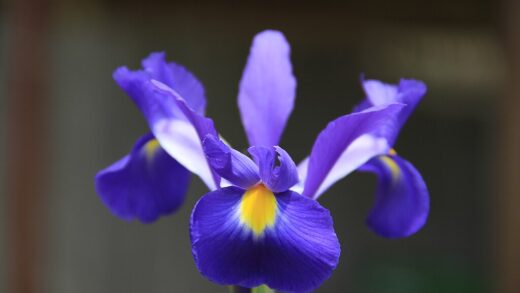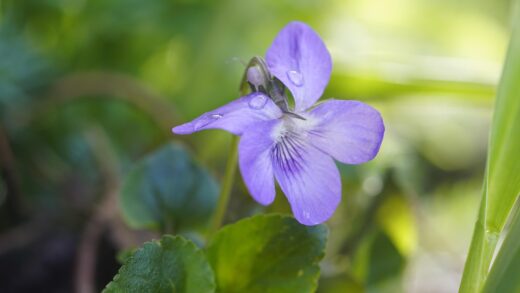Understanding the unique watering cycle
The key to correctly watering a madonna lily lies in a deep understanding of its distinctive annual growth cycle, which dictates its fluctuating need for moisture throughout the year. Unlike typical perennials that require consistent water during the summer growing season, the madonna lily follows a Mediterranean pattern of wet winters and dry summers. Its primary periods of active growth occur in the autumn, when it produces a basal rosette of leaves, and in the spring, when it sends up its flowering stalk. During these times, it requires a steady supply of moisture to fuel its development. However, it demands a period of relative dryness during its summer dormancy after flowering, a critical phase that is often misunderstood by gardeners.
This cycle means that your irrigation practices must change dramatically with the seasons. In autumn, as the new leaves emerge, you need to ensure the soil does not dry out completely. Regular rainfall may be sufficient, but during dry spells, supplemental watering is necessary to help the plant establish its winter foliage. This foliage is vital, as it works all winter long, photosynthesizing whenever conditions allow, to build up the energy reserves needed for the spectacular summer bloom. Without adequate moisture in the autumn, the foundation for the next year’s show is weakened.
As spring arrives, the lily’s water requirement increases significantly. This is the period of most rapid growth, as the tall flower stem elongates and buds begin to form. Consistent and deep watering is essential during this phase to support the development of strong stems and a large number of healthy flowers. Allowing the soil to become excessively dry during spring can lead to stunted growth, fewer buds, and a stressed plant that is more susceptible to pests and diseases. The goal is to maintain an evenly moist soil environment, avoiding both drought and waterlogging.
Following the flowering period in early to mid-summer, the plant’s needs undergo a complete reversal. As the foliage begins to yellow and die back, the bulb enters its crucial summer dormancy. During this time, you must drastically reduce watering. The bulb needs to rest and ripen in warm, relatively dry soil, which mimics the conditions of its native habitat. Continuing to water heavily during dormancy is one of the most common and fatal mistakes, as it almost inevitably leads to bulb rot. This dry rest period is not just a passive phase but an active requirement for the plant’s long-term health and future flowering.
Watering during active growth in spring
The spring season is a time of explosive growth for the madonna lily, and its demand for water is at its peak. From the moment the flower stalk begins to emerge from the center of the winter leaf rosette, the plant’s metabolic activity soars. It is drawing heavily on water and nutrients from the soil to build the tall, sturdy stem and develop the numerous flower buds that will soon put on their magnificent display. Your primary irrigation goal during this period is to provide consistent and reliable moisture to the root zone.
More articles on this topic
The best way to water is deeply and thoroughly, rather than little and often. Frequent, shallow watering encourages the development of a shallow root system, which makes the plant more vulnerable during dry spells. Instead, aim to provide a good soaking once or twice a week, depending on your climate and soil type, allowing the water to penetrate deep into the soil. You can check the moisture level by inserting your finger into the soil; if it feels dry an inch or two below the surface, it is time to water again.
The method of water application also matters. It is always best to water the soil at the base of the plant rather than watering from overhead. Wetting the dense foliage and developing buds can create an ideal environment for fungal diseases like botrytis blight, which can quickly disfigure or destroy the flowers. Using a soaker hose or a watering can with a long spout allows you to deliver water directly to the root zone where it is needed, keeping the leaves and flowers dry and healthy.
Be particularly attentive to the plant’s water needs as the flower buds begin to swell and show color. Any water stress at this critical stage can result in smaller blooms, bud drop, or a shortened flowering period. A layer of organic mulch around the base of the plant can be very beneficial during this time, as it helps to conserve soil moisture and keep the roots cool. By ensuring a steady supply of water throughout the spring, you provide the essential fuel for the plant to achieve its full, glorious potential.
Managing moisture during summer dormancy
After the madonna lily has finished its spectacular blooming period, a fundamental shift in its care, particularly regarding watering, is required. As the flowers fade and the foliage begins to yellow, the plant is signaling its transition into summer dormancy. This is a natural and necessary rest period. During this phase, which typically lasts from mid-summer through to early autumn, your irrigation practices must be adjusted to provide a much drier environment for the bulb. Continued heavy watering at this stage is a recipe for disaster.
More articles on this topic
The primary goal during dormancy is to allow the soil surrounding the bulb to dry out considerably. This dry, warm condition is essential for the bulb to ripen properly, which hardens its tissues and prepares it for the next growth cycle. It also significantly reduces the risk of fungal infections and bulb rot, to which dormant lily bulbs are highly susceptible in wet conditions. In most climates with moderate summer rainfall, you may not need to provide any supplemental water at all during this period.
If you live in a region with very dry, hot summers, you may need to provide a very light watering perhaps once every few weeks, just to prevent the bulb from completely desiccating. However, the soil should be allowed to dry out completely between these minimal waterings. For lilies planted in containers, this is even more critical, as pots can retain moisture longer. You must ensure the potting mix is almost entirely dry throughout the pot before even considering adding a small amount of water.
This period of “tough love” can feel counterintuitive to gardeners who are used to keeping their plants well-watered throughout the summer. However, respecting the madonna lily’s natural life cycle is paramount. This summer baking period is not a sign of neglect but a crucial cultural practice that ensures the bulb’s health and promotes the formation of flower buds for the following year. By withholding water, you are providing exactly what the plant needs to rest, recharge, and prepare for another beautiful display.
The critical role of soil drainage
While your watering technique is important, it is rendered ineffective if the underlying soil structure does not provide adequate drainage. For madonna lilies, excellent drainage is not just a preference; it is a prerequisite for survival. These bulbs have a very low tolerance for “wet feet” and will quickly succumb to rot if they are forced to sit in stagnant, waterlogged soil. Therefore, ensuring your soil drains freely is perhaps the most important factor in managing the plant’s water needs successfully.
The ideal soil is one that can retain enough moisture to support growth but also allows any excess water to pass through quickly. Sandy loam or gravelly soils are naturally well-suited for this purpose. If you are working with heavy clay soil, which is notorious for retaining water, significant amendment is necessary before planting. You can improve its structure and drainage by incorporating large amounts of organic matter like compost, as well as inorganic materials such as coarse sand, perlite, or fine horticultural grit.
Planting in raised beds is an excellent strategy for overcoming problems with poor drainage. By creating a raised growing area, you have complete control over the soil composition. You can fill the bed with a custom mix of topsoil, compost, and grit, creating the perfect, free-draining environment that madonna lilies crave. The elevated position of the bed naturally ensures that excess water drains away from the bulbs’ root zone, even during periods of heavy rainfall.
Even in well-draining soil, you can take an extra step to protect the bulb itself. When planting, it is a common and highly recommended practice to place a one-inch layer of coarse sand or grit at the bottom of the planting hole. You then set the bulb directly on top of this layer. This creates a small pocket of perfect drainage right under the base of the bulb, which is the area most susceptible to rot. This simple trick provides an extra layer of insurance against waterlogging and is a hallmark of meticulous lily cultivation.
Common watering mistakes and how to avoid them
One of the most frequent errors in madonna lily cultivation is overwatering, particularly during the wrong time of the year. The instinct for many gardeners is to provide ample water throughout the hot summer months, but for this specific lily, this can be a fatal mistake. Watering generously after the plant has finished flowering and is entering dormancy will almost certainly lead to bulb rot. To avoid this, you must learn to recognize the signs of dormancy—yellowing leaves and a withered stem—and be disciplined in cutting back water significantly during this period.
Another common mistake is applying water from overhead, allowing it to splash onto the leaves and flowers. While this might seem efficient, it creates a damp environment on the plant’s surface that is highly conducive to the development of fungal diseases, most notably botrytis blight. This disease causes unsightly spots on the leaves and can ruin the flowers completely. Always aim to water the soil directly at the base of the plant, using a soaker hose or careful hand-watering to keep the foliage as dry as possible.
Inconsistent watering during the crucial spring growth phase is another pitfall. Allowing the soil to swing between being bone dry and then suddenly saturated can stress the plant. This stress can manifest as weakened stems, a reduced number of flowers, or even bud blast, where the developing flower buds wither and drop before they have a chance to open. The key to avoiding this is regular monitoring of the soil moisture and providing deep, consistent watering to maintain an evenly moist environment throughout the spring.
Finally, a fundamental error is failing to address poor soil drainage before planting. No matter how perfect your watering technique is, if the water has nowhere to go, the bulb will suffer. Planting a madonna lily in heavy, compacted clay soil without amendment is setting it up for failure. To prevent this, always take the time to prepare the planting site thoroughly. Amend the soil to improve its porosity or, if necessary, build a raised bed to guarantee the sharp drainage these elegant plants absolutely require.


















